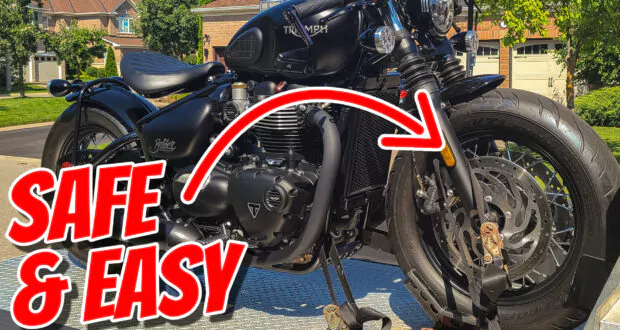Let’s look at how to tow a Triumph Bonneville bobber, including what you’ll need, where and how to strap down your motorcycle, and best practices for a safe and trouble-free tow.
Towing a Triumph Bonneville Bobber can be easy and safe as long as you use the right equipment, four endless loop ratchet straps, and strap it down correctly. Here’s how.


What you’ll need
In order to tow a Triumph Bonneville Bobber you’ll need some quality gear, including:
- Ratchet straps (4): Choose four ratchet straps, rather than the less expensive cinch strap options, as they are more heavier duty and rated for more weight. For extra safety, I use endless loop ratchet straps as these form a closed circle which your motorcycle will not be able to escape from, so you don’t have to worry about it falling over.
- Note: When shopping for ratchet straps, you need to understand that they have both a break strength rating, and a load capacity rating. Buy ratchet straps with a load capacity that is at least twice the weight of your motorcycle.
- A wheel chock (optional): You don’t need to use a wheel chock to tow a Triumph Bonneville Bobber, but it’ll be hard to strap down your motorcycle on your own without one. Unless you have a friend who can hold the bike upright (kickstand up) while you strap it down, you should consider my recommendation for an excellent motorcycle wheel chock.
- Note: Many wheel chocks are adjustable, you may need to adjust your wheel chock a bit to accommodate the Bonneville Bobber’s large front tire.
Step 1: Secure the Front End
If you have a wheel chock, set it up to fit the Bonneville Bobber’s front wheel. The wheel chock will you to stabilize the motorcycle. If you don’t have a front wheel chock you may want to ask a friend to sit on the bike and hold it level for you.
Begin by selecting a suitable anchor point on the motorcycle frame. I recommend strapping around the front fork lowers, where the front fender mounts. These are thick pieces of metal designed to handle a lot of force. They can handle some pressure. Just be sure to avoid speed sensors, brake lines, ABS sensors, or any other sensitive components.
In the past, people used to strap down from the motorcycle’s handlebars. I prefer strapping around the front fork lowers, over either where the fender mounts or where the brake caliper mounts. Strapping from the handlebars can cause excessive compression of the suspension, which can lead to premature wear on your front end components. By strapping around the fork lowers, as I demonstrate in the video, you can avoid causing your Bonneville Bobber any unnecessary wear.
Your straps should ideally be at a 45 degree angle forward, and a 45 degree angle outwards, in order to work best. I use endless loop ratchet straps because they allow me to create a closed circle around my motorcycle, like a hoop, from which it cannot escape or fall over.
Ensure your straps are tight, but not overly tight. Your suspension should be allowed to function properly, without allowing any opportunity for the motorcycle to escape.
Step 2: Secure the Bonneville Bobber’s rear end
You should always use four straps, rather than just two or three, to ensure maximum safety while towing any motorcycle. That way, in the event any one strap fails, there is another strap already working as a live back-up. The two extra straps at the rear also help to prevent your motorcycle from fish-tailing, if you needed to pull a high speed evasive maneuver.
When strapping the rear end of the motorcycle you must take care not to put any pressure on sensitive components. One easy location to strap to is around the front lower part of the frame.
By using four straps, all pulling forward, and outward, your bike is ready for anything. If a strap fails, or you need to swerve at high speeds, your motorcycle will still be prepared and undamaged.
Step 3: Take care of your straps
There are a number of things you can do to take care of your straps.
Keep your straps straight, without curls or twists that can create issues down the road.
Another potential hazard down the road is excess straps flapping in the wind. These loose straps could either damage your motorcycle’s paint, or worse, get cause around an axle and pull the motorcycle right over and cause an accident. In the video I demonstrate a special knot technique that I’ve used thousands of times. It’s quick, neat, safe, and secure.
Conclusions:
Towing a Bonneville Bobber can be easy and safe. Take your time, use the right gear, watch my how-to video, and use your common sense. Strap around thick solid metal like your frame or fork tube lowers. Keep your straps straight and tidy as close to 45 degree angles as possible. Enjoy the experience.
If you have any questions, or if you found this helpful, please leave me a comment down below.
 YouMotorcycle Motorcycle Blog – Motorcycle Lifestyle Blog, MotoVlog, Motorcycle Reviews, News, & How-Tos
YouMotorcycle Motorcycle Blog – Motorcycle Lifestyle Blog, MotoVlog, Motorcycle Reviews, News, & How-Tos
